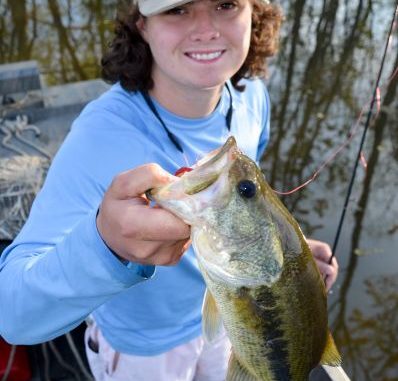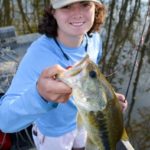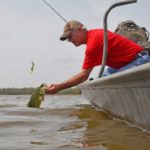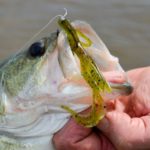
The portion of the Atchafalaya Basin within the guide levees gets most of the attention from bass anglers, but this grandfather-grandson team know just to the west is more consistent fishing. Here’s how they take advantage of that.
I sat quietly in the boat in front of the camp on Bird Island Chute. The swamp smelled fresh in the winter air. I thought about how good the caviar was the previous night.
Wait a minute ….
Caviar? In a swamp? In Louisiana?
Yeah, it was, indeed, part of the night’s feast (see this month’s Louisiana Seafood Bible cooking column elsewhere in this issue).
But today was for fishing.
My companions were Christopher Louviere, a student at the University of Louisiana at Lafayette and the owner of Internet clothes seller Swamp Savages; and his grandfather, Randy Montegut, owner of Bon Creole Seafood in New Iberia.
I had never been in this part of the Atchafalaya Basin before, let alone fished it. I was anxious to see how it differed from what is normally called the Atchafalaya Spillway — the part within the guide levees.
The 20-year-old Louviere has been badly bitten by the bass bug.
“I always fished with Poppa (Montegut) growing up, but not much bass,” the young angler explained. “Then I went to the Basin with a buddy in early high school.
“I didn’t really know what I was doing, but we tore them up. I really got into it. Whenever summer came around, I would hit the Basin or I would come out here (to the Lake Fausse Pointe-Lake Dauterive area) because we have a camp here.”
That has morphed into more than just fishing.
“For the last three years, my friends and I have held a bass tournament called SacMasters Classic in March or April,” Louviere said. “It started with 10 or 15 people, but is now over 30 people.
“Trophies are made of beer cans, fish hooks, lures and camp junk.”
I asked how good the fishing was here, outside the Basin’s levees.
“It’s pretty good,” Louviere said. “When the spawn is on, it’s really good. There are a lot of big bass in here because of Florida bass stockings.”
During warm winters, February is good, he said. So are March and April. The peak in March has a lot to do with the spawn.
Louviere was, however, quick to admit that fishing success goes down on cold days, even during peak periods.
On our trip, Louviere and Montegut would be chasing largemouths from a surface drive-powered boat, even though they had an outboard at the camp.
The motor choice was because much of the area can’t be accessed with an outboard during low water.
Some areas, like Sandy Cove, are permanently inaccessible to outboard-powered boats. From the Marshfield landing at Loreauville, the closest access to the best fishing is across a large, open area of Lake Fausse Pointe that is — at best — 1 foot deep.
Louviere said other access to the area is through Dauterive landing on Dauterive Lake, also at Loreauville.
Montegut piloted the custom-welded aluminum boat from Bird Island Chute through the Texaco Canal eastward to several bar pits off Bar Pit Canal.
The bar pits were created by the U.S. Army Corp “borrowing” dirt to make the western guide levees for the Atchafalaya Spillway.
Fishing here was, in a way, odd.
The scenery at first glance looked like the wild swamp of the Basin’s interior. Yet, periodically a dump truck, earth mover or road grader would thunder down the road on top of the levee that was barely visible through the trees.
So wild, yet so civilized.
Louviere started with an 8-inch, june bug-colored Berkeley Havoc Juice worm Texas-rigged with a 3/8-ounce bullet weight.
Montegut rigged up with a tequila sunrise lizard.
Louviere promptly put a bass in the boat; then another.
Montegut changed to a purple Senko; Louviere caught two more fish.
Montegut changed to a white spinner with a willow leaf blade.
Louviere caught another bass.
Finally, Montegut produced a strike from a rather modest crappie the angler held up with a chagrined smirk.
“Poppa is old-school,” Louviere chortled. “He’s always bringing out the old baits, saying this is what they used to catch them on.”
“I’m getting ready to prove it,” Montegut replied defiantly, thing on a double-bladed, double-hook, black-and-yellow H&H spinner. “This is the one that started it all — not all that modern B.S.”
“I’m throwing real close to the bank, real shallow,” Louviere coached his Poppa. “It’s pre-spawn, so they are guarding their nests.”
Louviere moved the worm with a slow, steady retrieve, bouncing it occasionally.
“Ooh, I got a bump,” Montegut exclaimed.
Before Montegut could finish his retrieve, Louviere quickly threw his worm into the same spot before Montegut could finish his retrieve, and almost immediately the youngster set the hook hard.
“You got my fish!” Montegut cried with mock indignation.
“No, I think that there are more there,” Louviere said.
“No. No. You caught my fish,” the old man grunted.
Fifteen minutes later, Montegut was still muttering.
“He caught the only fish I had a chance at,” he said.
Louviere was visibly amused
Montegut kept chunking his spinnerbait.
Louviere eyeballed his grandfather’s lure and smirked.
“You mean that really used to be a hot bait?” he asked.
“I’m gonna show you. I’m gonna show you,” Montegut promised.
Louivere tried to persuade his grandfather to change his approach.
“Poppa, the best lures here are watermelon or june bug Zoom Brush Hogs, watermelon Gary Yamamoto Senkos or chartreuse lizards,” Louviere explained.
“What about plain old black?” Montegut asked. “Black used to be good.”
“Never used black,” Louviere said.
Grumbling to himself, Montegut began digging in the tackle box.
“Tie a Brush Hog on,” the youngster urged.
The older man was defiant.
“I want to catch them on an H&H,” Montegut fired off.
Louviere didn’t give him a break.
“Well how’s that been working?” he said to his grinning grandfather.
“I’m going to catch them on this,” Montegut declared.
He had tied on a Senko-style worm.
His first cast sailed it into a tree — a tall tree. Goodbye, worm.
The duo fished past a big, modern metal-flake bass boat. The guy on the bow nailed a 2-pounder, quickly yanked it in and even more quickly released it so he could cast again.
Montegut said nothing, but when they were out of earshot, he spoke quietly to his grandson.
“I don’t want you to become like that: releasing fish, and with a big bass boat running over everyone,” Montegut said.
Louviere nodded agreement out of respect, but made an admission.
“But it sure would be fun to have a bass boat,” he said.
I caught that and questioned why.
“Cause they are fast,” Louviere said.
“I knew you were going to say that,” an eavesdropping Montegut said.
To redeem himself in the eyes of his grandfather, the youngster mended fences a bit.
“I keep fish because I like to eat them as much as catch them,” Louviere said.
“Yeah, I taught you better than (to release fish),” Montegut said with satisfaction.
But his grandson said he didn’t brag too much about taking bass home.
“I don’t talk about that much with other fisherman,” Louviere said. “You can get in a lot of arguments.”
“Yeah” his grandfather agreed. “I don’t fish enough to get in arguments over stupid stuff that doesn’t matter.”
Montegut palmed a new casting reel, while examining it.
“These new reels have a higher speed than they used to have,” he said. “They were 5:1 back then. We used to use Ambassador 5000s.”
Louviere made a quick observation just before setting the hook on a 2-pounder.
“(That reel) feels like a brick in your hands,” he said.
“I see what the plan is now,” Montegut grunted. “The less I catch, the better you look.”
Montegut was ready to move.
The first stop was Coon Slough, where the water looked milky and unfishable.
“When the water gets clear here, it’s real good fishing,” Louviere said. “It’s a good spawning area. It’s very shallow, and few outboards run it.”
They made a few desultory casts, and then cranked up and moved farther up Coon Slough to where it deepened near the opening to Sandy Cove. They then cruised into the cove itself.
Sandy Cove is a large, open, but very shallow lake. During the warmer months the entire lake is choked with the giant lily pad-like leaves of American lotus that Louviere referred to as “grandy volays,” a local pronunciation of the Cajun French “graine à volers.”
But was wide open on this Febuary trip, except for ragged patches of water lilies and a few beat-up clumps of cutgrass.
“Is this spinnerbait country,” Montegut queried hopefully?
Louviere simply sighed and tied a watermelon Brush Hog on his Poppa’s line.
“That’s my favorite color,” Louviere explained.
“I hate green,” Montegut grumbled, while he inspected the unnatural-looking lure dangling from his rod tip.
They fished the eastern shoreline with no results. Louviere used the trolling motor to move the boat to within casting distance of several raggedy cut grass plants forlornly isolated away from the lakeshore.
Bang!
“There he is,” Montegut grunted.
He missed that strike, but cast again to the same spot and came back with a 1 ½-pounder out of 18 inches of water.
“Well, I guess I like green now,” Montegut said as he held up the fish. “My new favorite color.”
Louviere maneuvered the boat closer to the center of the lake, into a patchy mosaic of runty water lilies. His intent was to fish the edges of the lily beds, but paradoxically the water was too clear.
In the gin-clear, 18-inch deep water, bass were visible all around and under the boat— but they refused to take the bait, even on long casts.
Louviere suspected the fish were being spooked by the boat.
He picked up the trolling motor and told his grandfather to use the surface drive engine to bull the skiff through the big mat of water lilies to open water on the other side.
The change was remarkable. In 50 yards the water changed from crystal clear to more-stained and definitely fishy.
Montegut hooked up with a 2-pounder on his first cast near the edge of the lilies.
After he thumped the third fish in a row, Louviere yelled out. “That’s it,” he said. “I’ve had enough; I’m putting on a Brush Hog, too.”
Montegut hooked and lost two more bass before his grandson could join in the fun with a small keeper.
The pair really began perking now. A peek in the ice chest showed nothing but green fish. Both the edge of the lilies and the measly little clumps of cut grass held fish.
At 1:30 p.m., they declared victory, with a box comfortably filled with 2-pound bass.
They didn’t have the 5-pounder that Louviere had his sights set on, but they had supper — a big supper.



